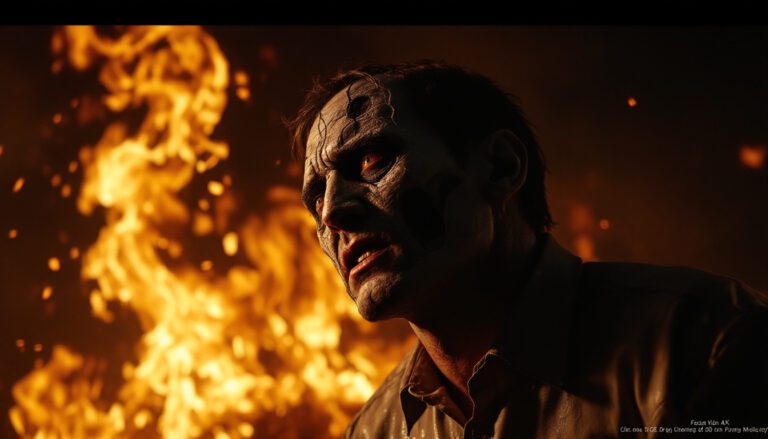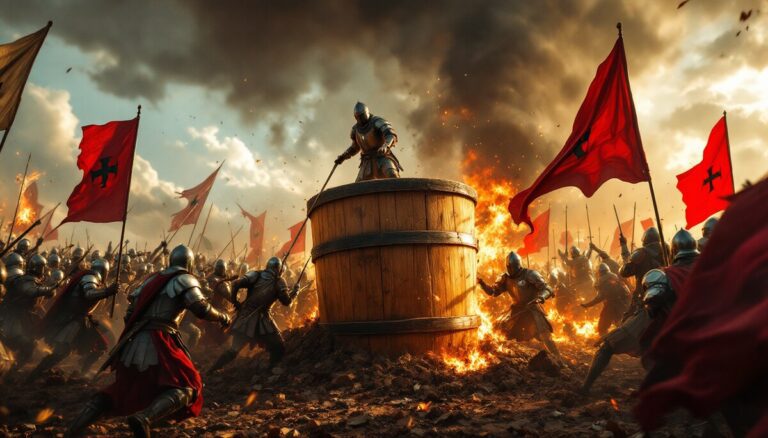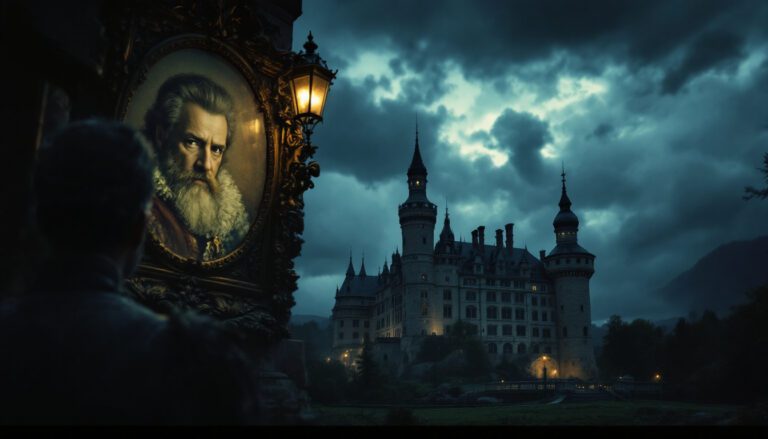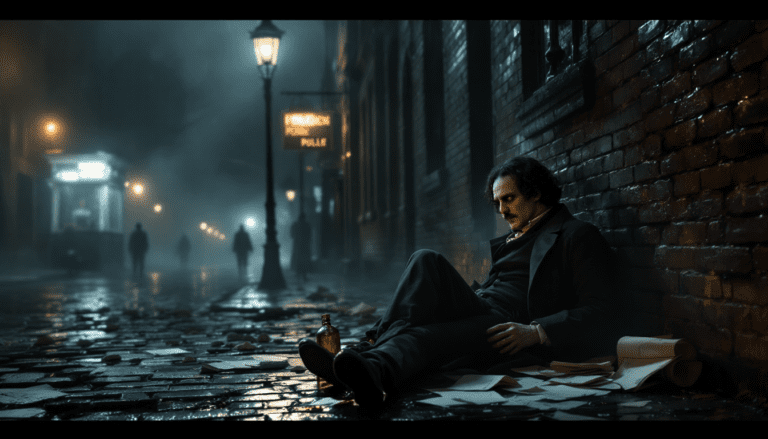Princes in the Tower: Did Richard III Kill Them?
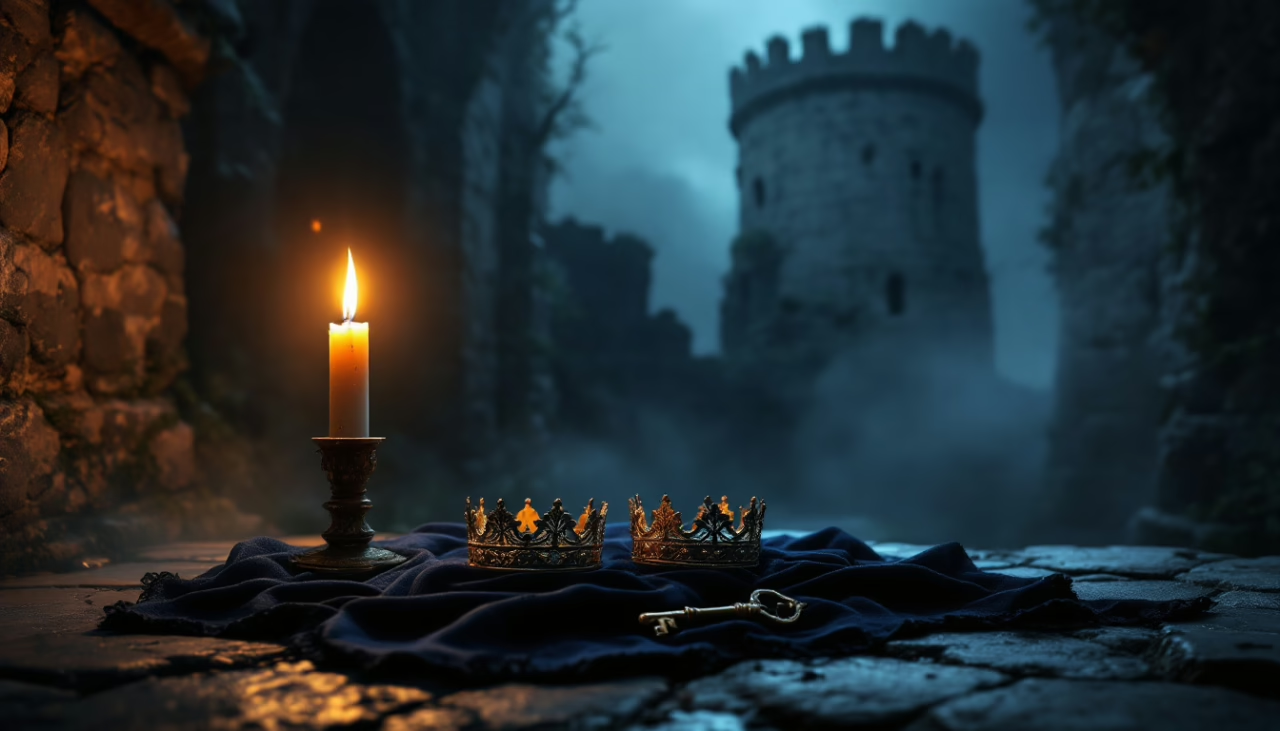
The disappearance of the Princes in the Tower raises critical questions about power and ambition in medieval England.
Richard III, often labeled the main suspect, faced significant threats to his claim as king.
Yet, the absence of definitive evidence complicates the narrative. Was he a calculated murderer or a victim of circumstance?
As speculation continues, the truth behind their fate remains elusive, inviting further examination of the motivations and implications of this historical mystery.
Key Takeaways
Hide- Richard III's rapid ascent to the throne raised suspicions about his involvement in the disappearance of his nephews, Edward V and Richard of Shrewsbury.
- Theories suggest that Richard may have seen the princes as threats to his claim, motivating potential foul play.
- Historical accounts describe the princes' last confirmed sightings in early July 1483, shortly before they vanished from the Tower of London.
- The discovery of bones in 1674 spurred debates about the princes' fate, with some attributing their deaths to Richard's ambition.
- Ongoing historical gaps and lack of concrete evidence leave the question of Richard's culpability open to interpretation and speculation.
The Vanishing Heirs: A Royal Puzzle Begins
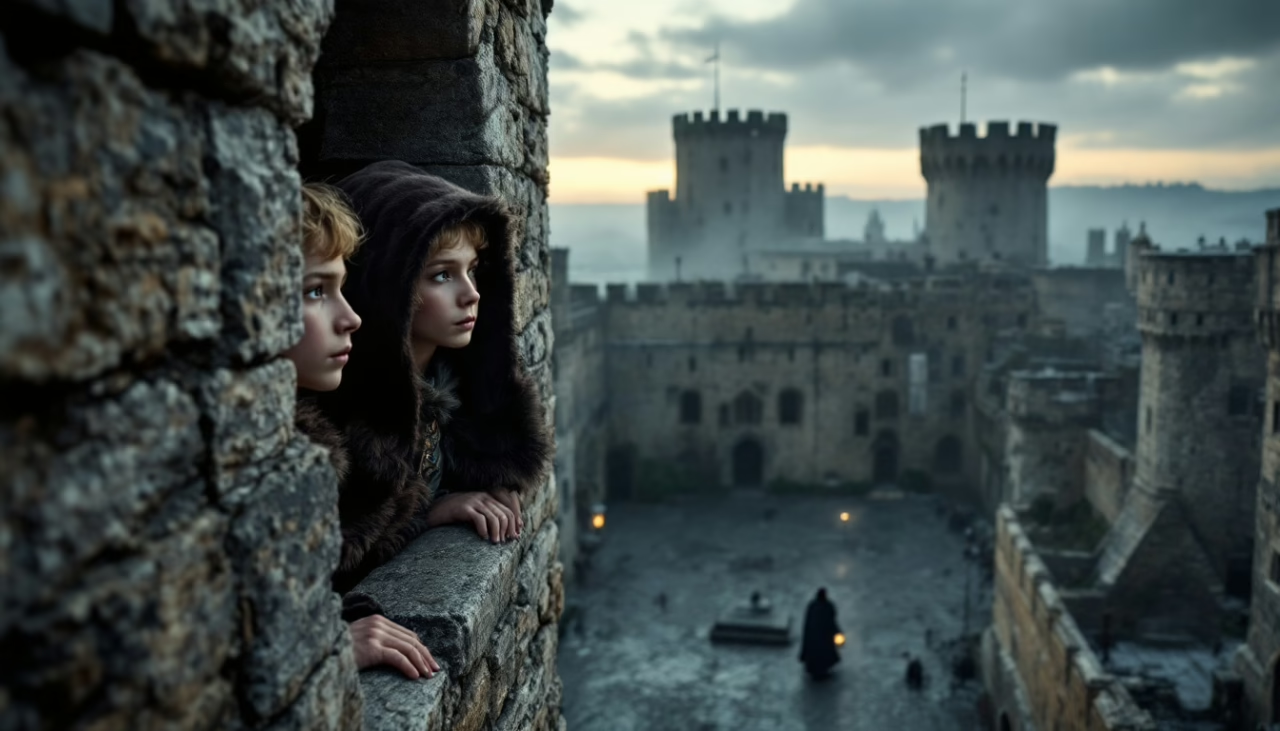
In 1483, the sudden disappearance of Edward V and his younger brother from the Tower of London marked the beginning of a troubling enigma in English history.
These young heirs, once poised to inherit the throne, were effectively locked away, their fate shrouded in mystery and speculation.
As the political landscape shifted dramatically around them, questions surrounding their disappearance have continued to captivate historians and royal enthusiasts alike.
Who Were the Princes: Edward V and His Brother
Edward V, the boy king, ascended to the throne at the tender age of twelve, yet his reign was tragically fleeting and shrouded in uncertainty.
His younger brother, Richard of Shrewsbury, remained in the shadows, often overlooked in the narrative of royal succession.
Together, these princes represent a poignant enigma in history, raising questions about their fates and the tumultuous power struggles of their time.
The Boy King: Edward V’s Brief Reign
How did a mere twelve-year-old ascend to the throne of England, only to be engulfed by the shadows of power struggles and intrigue?
Edward V’s reign, lasting scant weeks, epitomized the fragility of youth against political machinations.
With a regent poised to seize control, the boy king became an emblem of vulnerability, his potential overshadowed by the relentless pursuit of power surrounding him.
Richard of Shrewsbury: The Younger Shadow
Although overshadowed by his brother’s brief reign, Richard of Shrewsbury, the Duke of York, played an essential role in the unfolding drama of the English monarchy during a tumultuous period.
His existence symbolized both hope and vulnerability within the royal lineage. As questions arose regarding their legitimacy, Richard’s fate became a significant piece in the complex puzzle of power and survival, illustrating the precariousness of royal bloodlines.
Locked Away: The Tower of London in 1483
The Tower of London, a formidable symbol of royal authority, was selected as the prison for Edward V and his brother, a decision laden with political implications.
The last confirmed sightings of the young princes marked a critical juncture in history, as their abrupt disappearance stoked speculation and intrigue.
Analyzing the motivations behind their confinement and the circumstances surrounding their vanishing reveals deeper layers of power struggles and the precarious nature of legitimacy in 1483.
A Royal Prison: Why the Tower Was Chosen
Choosing the Tower of London as a prison for the young princes was a decision steeped in both symbolism and practicality, reflecting the turbulent political landscape of 1483.
The Tower, a formidable fortress, served not only to contain potential rivals but also to showcase royal power.
Its historical significance and strategic location made it a chilling reminder of the precariousness of royal lineage and ambition.
The Last Sightings: When the Boys Disappeared
How did the young princes, Edward and Richard, seemingly vanish from the confines of the Tower of London in the summer of 1483?
Witnesses reported seeing them last in early July, their playful spirits replaced by an eerie silence.
As rumors swirled, speculation grew regarding their fate. The disappearance ignited debates about loyalty, ambition, and the treacherous politics that ensnared England’s royal lineage.
The Power Struggle: England’s Throne at Stake
The struggle for England’s throne during the late 15th century was marked by intricate alliances and fierce rivalries, with Richard III positioned as both protector and potential usurper of his nephews.
As the uncle turned suspect, his motivations remain shrouded in suspicion, inviting speculation about his involvement in their mysterious disappearance.
Meanwhile, lurking in the shadows were other power players, each vying for dominance in a landscape fraught with betrayal and ambition.
Richard III: Uncle Turned Suspect
Richard III’s ascension from the role of protector to king raises critical questions about his motivations and the timing of his actions.
With the young princes posing a potential threat to his claim, their disappearance casts a shadow of suspicion on Richard, inviting speculation about whether he orchestrated their demise.
An examination of the political landscape of the time reveals a complex web of ambition, opportunity, and the ruthless pursuit of power.
From Protector to King: Richard’s Swift Rise
Amidst the turbulent landscape of 15th century England, few figures emerged as dramatically as Richard III, whose ascent from protector of the young Edward V to king was marked by a complex interplay of ambition and treachery.
This shift not only reshaped the power dynamics of the time but also ignited fierce debates about loyalty, legitimacy, and the moral ambiguities inherent in the pursuit of power.
Motive and Opportunity: Did He Order the Deed?
With the crown now firmly within his grasp, questions regarding the fate of Edward V and his brother Richard loomed large.
Richard III’s ascent raised suspicions about his motives. Could the elimination of his nephews have been a calculated move to secure his throne?
The absence of credible witnesses and the political climate of the time fuel speculation, leaving the truth shrouded in historical ambiguity.
Other Players: Rivals in the Shadows
In the turbulent landscape of England’s monarchy, figures like Henry Stafford and Margaret Beaufort emerged as formidable players in the quest for power.
Stafford, as Duke of Buckingham, harbored ambitions that could reshape the throne, while Beaufort’s maternal instincts masked a relentless pursuit of influence for her son, Henry Tudor.
Their actions, often shrouded in secrecy, highlight the complex interplay of motives that defined this perilous era.
Henry Stafford’s Ambitions: A Duke’s Dark Role?
Although often overshadowed by more prominent figures in the tumultuous landscape of 15th-century England, Henry Stafford, the Duke of Buckingham, played a pivotal role in the power struggle for the throne.
His ambitions were fueled by a desire for influence and control, leading him to navigate a treacherous path.
Ultimately, his actions would intertwine with the fate of the young princes, amplifying the chaos.
Margaret Beaufort: A Mother’s Quest for Power
While the political arena of 15th-century England was dominated by powerful figures and shifting allegiances, Margaret Beaufort emerged as a formidable force, driven by an unyielding ambition to see her son, Henry Tudor, ascend to the throne.
Her strategic alliances and relentless pursuit of power showcased a mother’s fierce devotion, ultimately transforming her from a mere pawn into a key player in the tumultuous struggle for the English crown.
Theories of Fate: What Happened to the Boys?
The fate of the young princes remains shrouded in mystery, with theories ranging from their grim murder to the possibility of a covert escape.
This duality raises compelling questions about the nature of power and survival in a politically charged atmosphere.
As historians sift through evidence and speculation, the truth behind what truly happened to the boys continues to captivate and perplex.
Murdered in Secret: The Grim Accusation
The fate of the Princes in the Tower remains shrouded in mystery, with the theory that they were smothered in their sleep representing a chilling narrative that has captivated historians.
The discovery of bones in 1674 reignited debates about their fate, leaving questions about the authenticity of this evidence and its implications.
As speculation continues, the intersection of historical records and folklore complicates the understanding of what truly happened to the young royals.
Smothered in Sleep: The Classic Claim
Although speculation abounds regarding the fate of the young princes, the theory that they were smothered in their sleep remains one of the most chilling and enduring narratives in the saga of Richard III.
This claim evokes a visceral horror, suggesting a betrayal of innocence. Its haunting implications compel historians and enthusiasts alike to scrutinize motivations and moral decay in the quest for power.
Evidence or Gossip: Bones Found in 1674
In 1674, a discovery in the Tower of London sparked renewed interest in the fate of the young princes, as bones were unearthed during renovations.
This find prompted speculation regarding their potential identities and the circumstances of their demise, leading historians to contemplate:
- The age of the bones
- Their condition
- Historical records
- Corroborating evidence
Such elements fueled ongoing debates about Richard III’s culpability.
Hidden Survivors: Did They Escape?
The possibility that the princes survived their imprisonment has sparked intriguing theories, particularly the claim of Perkin Warbeck, who asserted to be one of the boys.
This narrative raises questions about the nature of identity and legitimacy in a turbulent political landscape.
Additionally, speculation about a quiet exile for the princes invites scrutiny of historical records and the motivations of those who sought to reshape their fates.
Pretenders and Rumors: Perkin Warbeck’s Tale
What if the young princes, Edward and Richard, had not met their tragic fate at the hands of Richard III?
The emergence of Perkin Warbeck as a pretender raises intriguing questions about their possible survival:
- Claims of royal heritage
- Support from foreign powers
- Public fascination and belief
- The role of deception in political power
These elements contribute to the enduring mystery surrounding the fate of the princes.
A Quiet Exile: Could the Princes Have Lived?
Could the young princes, Edward and Richard, have evaded their grim fate and lived in quiet exile?
Various theories suggest that they may have escaped the Tower, blending into society or finding refuge abroad.
Such narratives feed the imagination, raising questions about identity, survival, and the relentless pursuit of freedom amidst the treachery of power.
Their potential existence remains a haunting enigma in history.
The Evidence: Clues Lost to Time
The quest for truth regarding the fate of the Princes in the Tower is complicated by both the bones debate and significant gaps in historical records.
Recent discoveries have sparked controversy over their authenticity, raising questions about the reliability of evidence purportedly linked to the royal siblings.
As historians sift through fragments of the past, the missing pieces of this tragic puzzle underscore the challenges in reconstructing an accurate narrative.
The Bones Debate: A Discovery Under Scrutiny
Recent discoveries of skeletons beneath the Tower of London have reignited historical debates regarding the fate of the princes.
However, modern scientific testing has encountered complications, raising questions about the reliability of the evidence.
As researchers grapple with these challenges, the possibility of uncovering definitive answers remains tantalizing yet elusive.
The Tower’s Secret: Skeletons Unearthed
Amidst the shadowy history of the Tower of London, a significant archaeological discovery has reignited debate over the fate of the two young princes, Edward V and his brother Richard.
- Two skeletons were unearthed
- Their ages correspond with the princes
- Historical records hint at foul play
- Speculations about Richard III’s involvement grow
This evidence raises questions about truth, memory, and the quest for justice.
Modern Science Stalls: Why Testing Falters
How can modern science, with its advanced methodologies and technologies, encounter such limitations when examining historical evidence?
The challenge lies in the degradation of time, which obscures essential clues. Testing often falters due to insufficient context or contamination of samples, leading to ambiguous results.
As researchers grapple with these barriers, the quest for definitive answers about the princes’ fate remains tantalizingly elusive.
Missing Records: Gaps in the Story
The historical account of the princes in the Tower is riddled with absences, leaving significant gaps in understanding their fate.
Essential documents from that era remain silent, providing little insight into the events surrounding their disappearance.
Furthermore, the absence of firsthand witnesses further complicates the narrative, as the voices that could shed light on this mystery have long since faded.
Silent Chronicles: What Documents Don’t Say
What remains unspoken in historical narratives often shapes the understanding of pivotal events, such as the fate of the Princes in the Tower.
The absence of key documents leads to speculation and uncertainty, emphasizing the need for critical examination of what is missing:
- Incomplete royal archives
- Lost correspondence between nobles
- Unrecorded eyewitness accounts
- Gaps in official court records
These silent chronicles fuel the mystery surrounding their demise.
Witnesses Gone: No One Left to Tell
Echoes of the past linger in the shadows of history, yet the absence of firsthand accounts regarding the Princes in the Tower leaves a haunting silence.
With witnesses long gone, critical evidence remains elusive. Missing records and unrecorded testimonies create profound gaps, obscuring the truth.
The desire for clarity is stifled, leaving speculation to flourish in the absence of definitive answers.
Why the Mystery Endures: A Timeless Enigma
The enduring mystery of the Princes in the Tower is intricately woven into the fabric of historical narrative and cultural interpretation.
Shakespeare’s portrayal of Richard III as the quintessential villain has cemented a lasting fascination with the story, shaping public perception and historical inquiry alike.
As interest in the tragic fate of the young princes persists, their legacy continues to provoke debate and speculation, underscoring the complexities of truth within history.
Shakespeare’s Spin: The Villainous Richard III
Shakespeare’s portrayal of Richard III has indelibly influenced public perception, framing the king as the archetypal villain.
This dramatic interpretation raises questions about the intersection of historical fact and theatrical embellishment, suggesting that the narrative may be more fiction than reality.
As the legend persists, it underscores the enduring power of drama to shape historical discourse and maintain intrigue surrounding the fate of the princes in the Tower.
A Playwright’s Lens: Shaping the Narrative
How does a singular portrayal shape the perception of history? Shakespeare’s depiction of Richard III cemented a narrative that endures through time, obscuring complexities.
This theatrical lens influences public understanding, emphasizing:
- The archetype of the villain
- The moral dichotomy of good versus evil
- The emotional resonance of betrayal
- The manipulation of historical truth
Such elements contribute to the enduring mystery surrounding Richard’s legacy.
Fact or Fiction: How Drama Fuels the Tale
Artistic interpretations often blur the lines between fact and fiction, particularly in historical narratives.
Shakespeare’s portrayal of Richard III as a scheming villain not only captivated audiences but also entrenched the ambiguity surrounding the fate of the princes.
This dramatization transformed a political mystery into a timeless enigma, inviting continual debate and speculation, as the allure of villainy often overshadows the search for truth.
Today’s Fascination: The Princes Live On
The enduring allure of the Princes in the Tower lies in their tragic narrative, which continues to captivate audiences across books and screens.
This persistent fascination reflects a broader human inclination to grapple with unsolved histories, inviting speculation and reinterpretation.
As new interpretations emerge, the mystery not only survives but thrives, prompting ongoing inquiry into the fate of these lost royal figures.
Books and Screens: Retelling the Tragedy
Why does the mystery of the Princes in the Tower continue to captivate audiences centuries after their disappearance?
The retelling of this tragedy in literature and film evokes intrigue and speculation.
Key elements that sustain interest include:
- The unresolved fate of the princes
- The moral ambiguity of historical figures
- The dramatic potential for storytelling
- The exploration of power and innocence
These themes resonate with contemporary audiences.
Unsolved History: Why We Keep Searching
How does a historical mystery maintain its grip on the collective imagination through centuries?
The case of the Princes in the Tower exemplifies humanity’s yearning for resolution amid uncertainty. This enigma embodies deeper themes of power, betrayal, and innocence, resonating with contemporary audiences.
As long as questions remain unanswered, the allure of the mystery guarantees that the Princes, symbolically, will never fade from memory.
Wrapping Up
The disappearance of the Princes in the Tower remains a haunting specter in England’s history, a riddle wrapped in the shadows of ambition and betrayal.
Each theory, like a thread in a complex tapestry, weaves a narrative that captivates the imagination.
As long as questions linger and evidence eludes definitive interpretation, the enigma will persist, inviting new generations to peel back the layers of this royal mystery. In the end, the truth may be as elusive as the boys themselves.
